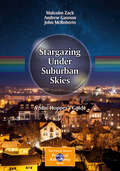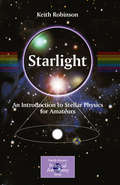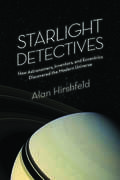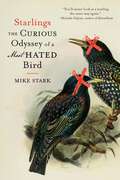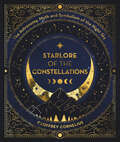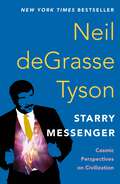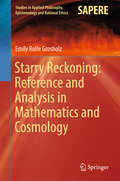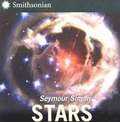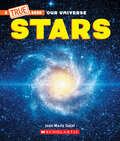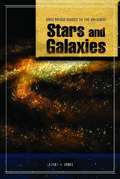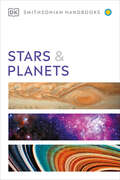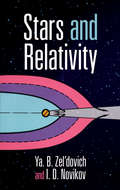- Table View
- List View
Stargazing Under Suburban Skies: A Star-Hopper's Guide (The Patrick Moore Practical Astronomy Series)
by Malcolm Zack Andrew Gannon John McRobertsAnyone interested in astronomy battles with the conveniences of modern living – street lights, advertising and security lighting, tall buildings, and even the occasional tree. More than 85% of the population now lives in crowded and light-polluted towns and cities. This book is for those who live in or near towns and cities and own relatively modest equipment, although observers with larger instruments will still find many of the target objects of interest. The book encourages the use of star-hopping techniques to find objects in the night sky.Included is a list of 100 popular deep sky objects, ranked according to how difficult they are to find. Each object is described and has companion star-hopping charts, images and sometimes sketches. As a result, readers can gain a sense of their own backyard view from Earth. There is also a top 30 list of lunar objects, a section on planetary observing, annotated lists of popular astronomy apps and software, and tips on how to make the most of your location.Stargazing Under Suburban Skies: A Star-Hopper’s Guide is the essential companion to what can be seen and how, regardless of the obstacles.
Stargazing: Photographs of the Night Sky from the Archives of NASA
by Nirmala NatarajThis collection of photographs illuminates the darkness of space in a whole new way. Images from the archives of NASA reveal the night sky's most extraordinary phenomena, from the radiant aurora borealis to awe-inspiring lunar eclipses. Science geeks, photography fans, and stargazers will pore over this earth's eye view of the cosmos. Each breathtaking photo is paired with an informative caption about the scientific phenomena it reveals and the technology used to capture it. Featuring a preface by Bill Nye, this ebook will rekindle the wonder of looking up at the stars.
Starlight
by Keith RobinsonThis is a book about the physics of stars and starlight. The story of starlight is truly fascinating. Astronomers analyze and interpret the light from stars using photometry and spectroscopy, then inspirational detective work combines with the laws of physics to reveal the temperatures, masses, luminosities and outer structure of these far away points of light. The laws of physics themselves enable us to journey to the very center of a star and to understand its inner structure and source of energy! Starlight provides an in-depth study of stellar astrophysics that requires only basic high school mathematics and physics, making it accessible to all amateur astronomers. Starlight teaches amateur astronomers about the physics of stars and starlight in a friendly, easy-to-read way. The reader will take away a profoundly deeper understanding of this truly fascinating subject - and find his practical observations more rewarding and fulfilling as a result.
Starlight Detectives
by Alan HirshfeldDiscover magazine "Top 5 Summer Read"Scientific American "Recommended" feature review"A masterful balance of science, history and rich narrative." -Discover magazine"Starlight Detectives is just the sort of richly veined book I love to read-full of scientific history and discoveries, peopled by real heroes and rogues, and told with absolute authority. Alan Hirshfeld's wide, deep knowledge of astronomy arises not only from the most careful scholarship, but also from the years he's spent at the telescope, posing his own questions to the stars." -DAVA SOBEL, author of A More Perfect Heaven: How Copernicus Revolutionized the Cosmos and LongitudeIn 1929, Edwin Hubble announced the greatest discovery in the history of astronomy since Galileo first turned a telescope to the heavens. The galaxies, previously believed to float serenely in the void, are in fact hurtling apart at an incredible speed: the universe is expanding. This stunning discovery was the culmination of a decades-long arc of scientific and technical advancement. In its shadow lies an untold, yet equally fascinating, backstory whose cast of characters illuminates the gritty, hard-won nature of scientific progress.The path to a broader mode of cosmic observation was blazed by a cadre of nineteenth-century amateur astronomers and inventors, galvanized by the advent of photography, spectral analysis, and innovative technology to create the entirely new field of astrophysics. From William Bond, who turned his home into a functional observatory, to John and Henry Draper, a father and son team who were trailblazers of astrophotography and spectroscopy, to geniuses of invention such as Léon Foucault, and George Hale, who founded the Mount Wilson Observatory, Hirshfeld reveals the incredible stories-and the ambitious dreamers-behind the birth of modern astronomy.Alan Hirshfeld, Professor of Physics at the University of Massachusetts Dartmouth and an Associate of the Harvard College Observatory, is the author of Parallax: The Race to Measure the Cosmos, The Electric Life of Michael Faraday, and Eureka Man: The Life and Legacy of Archimedes.
Starlings: The Curious Odyssey of a Most Hated Bird
by Mike StarkHas there ever been a more hated bird than the European starling? Let loose in New York City&’s Central Park by a misguided aristocrat, the starlings were supposed to help curb insect outbreaks and add to the tuneful choir of other songbirds. Rather than staying put, the dark and speckled starlings marched across the continent like a conquering army. In less than sixty years, they were in every state in the contiguous United States and their numbers topped two hundred million. Cities came under siege; crops buckled beneath their weight. Public sentiment quickly soured. A bitter, baffling, and sometimes comical war on starlings ensued. Weapons included dynamite, guns, bounties, fake owls, real owls, rubber snakes, balloons, itching powder, and greased building ledges. Still, artists and scientists marveled at their undulating aerial formations, which seemed equal parts poetry and mathematics. Keen listeners recognized the starling as one of the world&’s great vocal mimics, imitating everything from fellow birds and cell phones to barking dogs, car alarms, and TV commercials. And then there were their undeniable skills of adaptation and survival. What if there was more to these stubborn villains than once thought? Mike Stark&’s Starlings is a first-of-its-kind history of starlings in America, an oddball, love-hate story at the intersection of human folly, ornithology, and one bird&’s tenacious will to endure.
Starlore of the Constellations: The Astronomy, Myth and Symbolism of the Night Sky
by Geoffrey CorneliusIMMERSE YOURSELF IN THE STORIES OF THE SKYDiscover the mysteries of celestial mythology with this comprehensive introduction to the constellations and the stars that comprise them. This fascinating practical guide unveils the myths, legends and symbolic significance that the stars have assumed in many cultures and ancient civilizations across the world. Illustrated with stunning artwork and detailed star maps: This is an essential guide for both beginner stargazers and experienced astronomers.Embark on a celestial journey: From Babylonians to Native Americans to Ancient Greeks, learn how humans have connected with the cosmos throughout history, shedding light on our continuing fascination with the heavens.No prior knowledge needed: This book focuses on aspects that can be seen with the naked eye or binoculars. It&’s also the ideal companion for mobile star-viewing apps.All 88 major and minor constellations, plus the planets, are included: Through the starlore of hundreds of individual stars, lose yourself in the magic of the night sky.
Starry Messenger: Cosmic Perspectives on Civilization
by Neil deGrasse TysonNEW YORK TIMES BESTSELLERBringing his cosmic perspective to civilization on Earth, Neil deGrasse Tyson shines new light on the crucial fault lines of our time—war, politics, religion, truth, beauty, gender, and race—in a way that stimulates a deeper sense of unity for us all.In a time when our political and cultural views feel more polarized than ever, Tyson provides a much-needed antidote to so much of what divides us, while making a passionate case for the twin chariots of enlightenment—a cosmic perspective and the rationality of science.After thinking deeply about how science sees the world and about Earth as a planet, the human brain has the capacity to reset and recalibrates life’s priorities, shaping the actions we might take in response. No outlook on culture, society, or civilization remains untouched.With crystalline prose, Starry Messenger walks us through the scientific palette that sees and paints the world differently. From insights on resolving global conflict to reminders of how precious it is to be alive, Tyson reveals, with warmth and eloquence, an array of brilliant and beautiful truths that apply to us all, informed and enlightened by knowledge of our place in the universe.
Starry Reckoning: Reference and Analysis in Mathematics and Cosmology
by Emily Rolfe GrosholzThis book deals with a topic that has been largely neglected by philosophers of science to date: the ability to refer and analyze in tandem. On the basis of a set of philosophical case studies involving both problems in number theory and issues concerning time and cosmology from the era of Galileo, Newton and Leibniz up through the present day, the author argues that scientific knowledge is a combination of accurate reference and analytical interpretation. In order to think well, we must be able to refer successfully, so that we can show publicly and clearly what we are talking about. And we must be able to analyze well, that is, to discover productive and explanatory conditions of intelligibility for the things we are thinking about. The book's central claim is that the kinds of representations that make successful reference possible and those that make successful analysis possible are not the same, so that significant scientific and mathematical work typically proceeds by means of a heterogeneous discourse that juxtaposes and often superimposes a variety of kinds of representation, including formal and natural languages as well as more iconic modes. It demonstrates the virtues and necessity of heterogeneity in historically central reasoning, thus filling an important gap in the literature and fostering a new, timely discussion on the epistemology of science and mathematics.
Stars
by Seymour SimonDiscusses the stars, their composition, and characteristics with actual photographs.
Stars (A True Book (Relaunch) #0)
by Joan Marie GalatDid you know that stars explode? Or that they can be different colors? Have you ever wondered how many stars exist in the universe or how they form? These are just a few of the topics covered through the pages of this book.From supergiants to white dwarfs, and star clusters to supernovae, readers will be consumed with fascinating facts and information about these bright, beaming objects in our universe.Planets and stars, moons and galaxies! The universe is a vast and mysterious place with much to explore. And there's no better way to make amazing discoveries about space than with this reimagined series. With the latest NASA imagery, the classic structure and features of A True Book, and lively text, the titles in Our Universe bring the awe of the cosmos directly to readers. Students will come away with a wealth of knowledge about the incredible celestial bodies in our universe.This series covers Next Generation Science Standards core ideas including "The Universe and its stars" and "Earth and the solar system."
Stars (Kaleidoscope)
by Roy A. GallantDescribes stars-- how they are formed, their composition, and what happens when they die.
Stars and Galaxies
by Lauren V. JonesOur knowledge of the universe has increased tremendously over the last century. We now know that our Milky Way galaxy is but one of hundreds of billions of galaxies; our solar system is not unique, since scientists have found other planets circling other stars throughout the galaxy. And our discoveries are not over--there still exist mysteries to be solved by the next generation of astronomers.
Stars and Planets: The Most Complete Guide To The Stars, Planets, Galaxies, And Solar System - Updated And Expanded Edition (DK Handbooks #114)
by Ian RidpathThe clearest, most accessible guide to observing the night sky.Introducing the Handbook of Stars and Planets - the perfect beginner's guide to the night sky!With a highly visual introduction that explains the basic concepts of astronomy and gives advice on the best methods and equipment for observation, including binoculars and telescopes, exploring the cosmos and more has never been easier or more accessible. Each of the planets in the Solar System is described and illustrated in detail, with images taken from space probes as well as from the ground, showing them as you can expect to see them.More than 160 star charts were made especially for this book by the Royal Greenwich Observatory. There is a separate detailed chart for each of the 88 constellations, adding up to a complete atlas of the sky. The text for each constellation reveals its history and mythology and lists notable stars, galaxies, nebulae, and other objects. Alongside the constellation profiles is a month-by-month guide, including a set of charts and a user-friendly text guide that picks out the highlights above your head each month.Soar into the pages of this awe-inspiring astronomy book to explore:- Introduction section provides an accessible primer on the basics of astronomy and skywatching- Equipment section includes a guide to the main kinds of binoculars, telescopes, and camera equipment- Practical advice also includes observing the sky with the naked eye- Profiles of planets and constellations include color-coded data tables, delivering fast facts for quick reference- Accesible text explains concepts clearly and guides the reader from beginner to intermediate-level astronomerThis newly updated guide to the Solar System includes new discoveries, revised data, and the latest images from space probes! The revisions to constellation and monthly sky guides include new data on stars and other objects such as galaxies, as well as a refreshed guide to binoculars, telescopes, and cameras. Complete with jargon-free text written by one of the foremost popularizers of astronomy and an authority on the history of constellations, the DK Handbook of Stars and Planets is the perfect introduction to stargazing! So whether you&’re a budding astronomer or an intermediate space savvy, this great guide to the night sky is suitable for children aged 12+ and adults alike, and promises something for everyone to explore, discover and love!
Stars and Relativity
by Ya. B. Zel’dovich I. D. NovikovThese authors ranked among the greatest astrophysicists of the 20th century, and their work is remarkable for its deep physical insights and clarity of presentation. This book explores general relativity, properties of matter under astrophysical conditions, stars, and stellar systems. It constitutes a valuable resource for today's physicists, astronomers, and graduate students. 1971 edition.
Stars and Relativity
by Ya. B. Zel’dovich I. D. NovikovThis edition reprints Volume 1 of an important two-volume Russian work which, at the time of its original publication, was the only comprehensive review in existence of the entire field of relativistic astrophysics. Subsequently revised and enlarged, both volumes remain today a valuable resource for physicists, astronomers, and others working in the field.The present volume is devoted to general relativity, properties of matter under astrophysical conditions, and stars and stellar systems. Individual topics include the theory of gravitation (including Einstein's gravitational equations), the equation of state of matter (cold matter, properties of matter at high temperatures, etc.) and relativistic stages of evolution of cosmic objects (equilibrium and stability of stars, stellar evolution, star clusters, more).The authors of this book rank among the great astrophysicists of the century: their work is especially remarkable for its deep physical insights and clarity of presentation. Those features are here in abundance, ready to inform and inspire both practicing astrophysicists and aspiring students.
Stars and Relativity
by Ya. B. Zel’dovich I. D. NovikovThis edition reprints Volume 1 of an important two-volume Russian work which, at the time of its original publication, was the only comprehensive review in existence of the entire field of relativistic astrophysics. Subsequently revised and enlarged, both volumes remain today a valuable resource for physicists, astronomers, and others working in the field.The present volume is devoted to general relativity, properties of matter under astrophysical conditions, and stars and stellar systems. Individual topics include the theory of gravitation (including Einstein's gravitational equations), the equation of state of matter (cold matter, properties of matter at high temperatures, etc.) and relativistic stages of evolution of cosmic objects (equilibrium and stability of stars, stellar evolution, star clusters, more).The authors of this book rank among the great astrophysicists of the century: their work is especially remarkable for its deep physical insights and clarity of presentation. Those features are here in abundance, ready to inform and inspire both practicing astrophysicists and aspiring students.
Stars and Relativity
by Ya. B. Zel’dovich I. D. NovikovThis edition reprints Volume 1 of an important two-volume Russian work which, at the time of its original publication, was the only comprehensive review in existence of the entire field of relativistic astrophysics. Subsequently revised and enlarged, both volumes remain today a valuable resource for physicists, astronomers, and others working in the field.The present volume is devoted to general relativity, properties of matter under astrophysical conditions, and stars and stellar systems. Individual topics include the theory of gravitation (including Einstein's gravitational equations), the equation of state of matter (cold matter, properties of matter at high temperatures, etc.) and relativistic stages of evolution of cosmic objects (equilibrium and stability of stars, stellar evolution, star clusters, more).The authors of this book rank among the great astrophysicists of the century: their work is especially remarkable for its deep physical insights and clarity of presentation. Those features are here in abundance, ready to inform and inspire both practicing astrophysicists and aspiring students.
Stars and Relativity
by Ya. B. Zel’dovich I. D. NovikovThis edition reprints Volume 1 of an important two-volume Russian work which, at the time of its original publication, was the only comprehensive review in existence of the entire field of relativistic astrophysics. Subsequently revised and enlarged, both volumes remain today a valuable resource for physicists, astronomers, and others working in the field.The present volume is devoted to general relativity, properties of matter under astrophysical conditions, and stars and stellar systems. Individual topics include the theory of gravitation (including Einstein's gravitational equations), the equation of state of matter (cold matter, properties of matter at high temperatures, etc.) and relativistic stages of evolution of cosmic objects (equilibrium and stability of stars, stellar evolution, star clusters, more).The authors of this book rank among the great astrophysicists of the century: their work is especially remarkable for its deep physical insights and clarity of presentation. Those features are here in abundance, ready to inform and inspire both practicing astrophysicists and aspiring students.
Stars and Relativity
by Ya. B. Zel’dovich I. D. NovikovThis edition reprints Volume 1 of an important two-volume Russian work which, at the time of its original publication, was the only comprehensive review in existence of the entire field of relativistic astrophysics. Subsequently revised and enlarged, both volumes remain today a valuable resource for physicists, astronomers, and others working in the field.The present volume is devoted to general relativity, properties of matter under astrophysical conditions, and stars and stellar systems. Individual topics include the theory of gravitation (including Einstein's gravitational equations), the equation of state of matter (cold matter, properties of matter at high temperatures, etc.) and relativistic stages of evolution of cosmic objects (equilibrium and stability of stars, stellar evolution, star clusters, more).The authors of this book rank among the great astrophysicists of the century: their work is especially remarkable for its deep physical insights and clarity of presentation. Those features are here in abundance, ready to inform and inspire both practicing astrophysicists and aspiring students.
Stars and Relativity
by Ya. B. Zel’dovich I. D. NovikovThis edition reprints Volume 1 of an important two-volume Russian work which, at the time of its original publication, was the only comprehensive review in existence of the entire field of relativistic astrophysics. Subsequently revised and enlarged, both volumes remain today a valuable resource for physicists, astronomers, and others working in the field.The present volume is devoted to general relativity, properties of matter under astrophysical conditions, and stars and stellar systems. Individual topics include the theory of gravitation (including Einstein's gravitational equations), the equation of state of matter (cold matter, properties of matter at high temperatures, etc.) and relativistic stages of evolution of cosmic objects (equilibrium and stability of stars, stellar evolution, star clusters, more).The authors of this book rank among the great astrophysicists of the century: their work is especially remarkable for its deep physical insights and clarity of presentation. Those features are here in abundance, ready to inform and inspire both practicing astrophysicists and aspiring students.
Stars and Relativity
by Ya. B. Zel’dovich I. D. NovikovThis edition reprints Volume 1 of an important two-volume Russian work which, at the time of its original publication, was the only comprehensive review in existence of the entire field of relativistic astrophysics. Subsequently revised and enlarged, both volumes remain today a valuable resource for physicists, astronomers, and others working in the field.The present volume is devoted to general relativity, properties of matter under astrophysical conditions, and stars and stellar systems. Individual topics include the theory of gravitation (including Einstein's gravitational equations), the equation of state of matter (cold matter, properties of matter at high temperatures, etc.) and relativistic stages of evolution of cosmic objects (equilibrium and stability of stars, stellar evolution, star clusters, more).The authors of this book rank among the great astrophysicists of the century: their work is especially remarkable for its deep physical insights and clarity of presentation. Those features are here in abundance, ready to inform and inspire both practicing astrophysicists and aspiring students.
Stars and Relativity
by Ya. B. Zel’dovich I. D. NovikovThis edition reprints Volume 1 of an important two-volume Russian work which, at the time of its original publication, was the only comprehensive review in existence of the entire field of relativistic astrophysics. Subsequently revised and enlarged, both volumes remain today a valuable resource for physicists, astronomers, and others working in the field.The present volume is devoted to general relativity, properties of matter under astrophysical conditions, and stars and stellar systems. Individual topics include the theory of gravitation (including Einstein's gravitational equations), the equation of state of matter (cold matter, properties of matter at high temperatures, etc.) and relativistic stages of evolution of cosmic objects (equilibrium and stability of stars, stellar evolution, star clusters, more).The authors of this book rank among the great astrophysicists of the century: their work is especially remarkable for its deep physical insights and clarity of presentation. Those features are here in abundance, ready to inform and inspire both practicing astrophysicists and aspiring students.
Stars and Relativity
by Ya. B. Zel’dovich I. D. NovikovThis edition reprints Volume 1 of an important two-volume Russian work which, at the time of its original publication, was the only comprehensive review in existence of the entire field of relativistic astrophysics. Subsequently revised and enlarged, both volumes remain today a valuable resource for physicists, astronomers, and others working in the field.The present volume is devoted to general relativity, properties of matter under astrophysical conditions, and stars and stellar systems. Individual topics include the theory of gravitation (including Einstein's gravitational equations), the equation of state of matter (cold matter, properties of matter at high temperatures, etc.) and relativistic stages of evolution of cosmic objects (equilibrium and stability of stars, stellar evolution, star clusters, more).The authors of this book rank among the great astrophysicists of the century: their work is especially remarkable for its deep physical insights and clarity of presentation. Those features are here in abundance, ready to inform and inspire both practicing astrophysicists and aspiring students.
Stars and Relativity
by Ya. B. Zel’dovich I. D. NovikovThis edition reprints Volume 1 of an important two-volume Russian work which, at the time of its original publication, was the only comprehensive review in existence of the entire field of relativistic astrophysics. Subsequently revised and enlarged, both volumes remain today a valuable resource for physicists, astronomers, and others working in the field.The present volume is devoted to general relativity, properties of matter under astrophysical conditions, and stars and stellar systems. Individual topics include the theory of gravitation (including Einstein's gravitational equations), the equation of state of matter (cold matter, properties of matter at high temperatures, etc.) and relativistic stages of evolution of cosmic objects (equilibrium and stability of stars, stellar evolution, star clusters, more).The authors of this book rank among the great astrophysicists of the century: their work is especially remarkable for its deep physical insights and clarity of presentation. Those features are here in abundance, ready to inform and inspire both practicing astrophysicists and aspiring students.
Stars and Relativity
by Ya. B. Zel’dovich I. D. NovikovThis edition reprints Volume 1 of an important two-volume Russian work which, at the time of its original publication, was the only comprehensive review in existence of the entire field of relativistic astrophysics. Subsequently revised and enlarged, both volumes remain today a valuable resource for physicists, astronomers, and others working in the field.The present volume is devoted to general relativity, properties of matter under astrophysical conditions, and stars and stellar systems. Individual topics include the theory of gravitation (including Einstein's gravitational equations), the equation of state of matter (cold matter, properties of matter at high temperatures, etc.) and relativistic stages of evolution of cosmic objects (equilibrium and stability of stars, stellar evolution, star clusters, more).The authors of this book rank among the great astrophysicists of the century: their work is especially remarkable for its deep physical insights and clarity of presentation. Those features are here in abundance, ready to inform and inspire both practicing astrophysicists and aspiring students.
